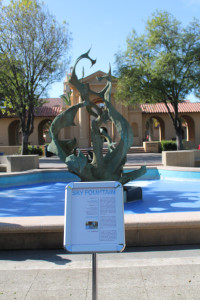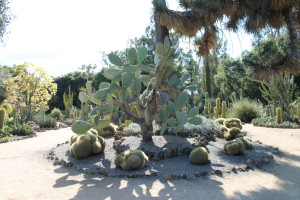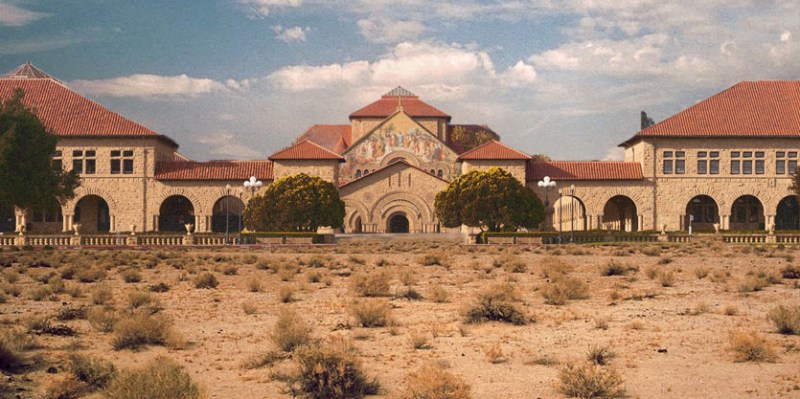Three Stanford seniors have spent the majority of their final undergraduate year pushing to see change on Stanford’s campus that they may never have the chance to enjoy as students.
Zack Gold ’15, Akshai Baskaran ’15 and Laura Cussen ’15 created a petition asking the University to replace “grass landscaping with drought-tolerant native plants.” The petition has over 800 signatures and has garnered the attention of students, faculty and University officials.
Gold initiated the idea because he kept hearing from students in Students for a Sustainable Stanford (SSS) that Stanford’s water use was the issue that bothered them most. The more Gold, who is the co-president of SSS, looked into the problem, the more he found that one of the main perpetrators of water waste was Stanford’s irrigation of lawns and plants. According to the petition, watering plants makes up 40 percent of Stanford’s annual water use.
“One of the biggest recurring arguments [by administrators] was, ‘students don’t actually want drought-resistant plants, they want green athletic fields,’” Gold explained. “We wanted to get rid of the myth that students don’t actually want drought tolerant landscaping.”

Gold, Baskaran and Cussen are thrilled with the response from the petition so far and note that over half of the signatures seem to come from alumni, dispelling the theory that Stanford needs to keep its green lawns for the sake of alumni who want to see Stanford when they visit.
“Actually, a lot of our signatures seem to be from alumni saying things like, ‘I always wished this had been a priority when I was a student,’” Cussen said.
The organizers emphasized that the petition was not targeting “signature Stanford” lawns like the Oval or Wilbur field, but instead focused on smaller features like strips on the sides of buildings.
“It might be unrealistic to think the historic lawns on campus will be changed to drought-resistant plants,” Cussen said. “We’re focusing on lawns that are underused and don’t add value to the university.”
Involving the University
Once hundreds of names began to appear on the online form, Gold contacted university officials to set up a meeting and present the petition and his ideas for Stanford’s future landscaping.
“Unfortunately, we got no response over and over again,” Gold recounted.
Baskaran, the head of the ASSU committee for energy and the environment, was able to step in after hearing Gold’s problems with communication and got in touch with the University Architect/Campus Planning and Design Office (UA/CPD). Baskaran set up a meeting with the office almost immediately. He admits his title and position on the ASSU probably helped him get a response from the university.
“When Zack told me about the petition and how he was having trouble getting in touch with university staff, I told him, ‘Literally the goal of my committee is to make sure we connect student groups with the university,’” Baskaran said.
The three authors of the petition scheduled a meeting with Cathy Blake, associate director of the UA & Planning Office, to present their petition and discuss plans for implementation.
“We set up a meeting and had the petition to say, ‘Look at this, students care about it.’ We really communicated that message, and we could tell they cared, too,” Baskaran said.
The students were overwhelmed by the amount of support they found. Because of the meeting, they were invited to look over plans for the current Meyer library green space, the Stanford Arboretum and other plans for the future of Stanford’s landscape.
“In general, it was great talking with the Students for Sustainable Stanford,” Blake said in a statement to The Daily. “What I explained to them was that Stanford is fortunate that the original principles that the University was founded on from the 19th century Olmsted days was that Stanford should employ climate-appropriate, low-water-using plants consistent with the California climate.”
With the positive response from Blake and her associates in the UA/CPD, Gold and Baskaran are optimistic about the continuation of student involvement in some of these decisions.
“We’re trying to do the same thing – we’re just approaching it from two different angles. Students and Stanford are now working to solve these problems together. These are things we both care about; if we combine our efforts, we’ll be able to do much more than we would individually,” Gold said. “Students really want to work with Stanford University.”
Gold noted that a main facet of the petition was to demonstrate to the university that students want to initiate change and help mold the place where they will be living for four years. For Baskaran, while the sustainability portion was important, the main point of this initiative was to create a working relationship between student groups and university officials.
“My main goal is to develop a long-term relationship with the [UA/CPD] so that students have more of a connection,” Baskaran explained. “I want to make sure students are more involved with decision making on campus, and we’re trying to do that across the university. Our main goal on campus is to allow students to have more of an impact.”
Baskaran is hopeful that his efforts will be carried on after he graduates in June.
“I’m really optimistic about the students’ role here on campus,” he said.
The Meyer Library Green Space
One of the main reasons why the petition was started earlier this year was to target the green space that will be created once the demolition of Meyer Library is complete. Gold, Baskaran and Cussen saw this as a place where their plans could soon come to fruition.
“Meyer was a good opportunity for a central, high profile place on campus to get drought-tolerant landscaping and use it to educate as well,” Cussen said, citing the fact that many Stanford students will bike and walk through the area every day. “This is going to be a nexus for students.”
Gold was excited to be shown the plans for the space and said the three approved of the ideas presented. According to Blake, Meyer, once demolished, will turn into a grassy area for student uses encircled by drought-resistant plants.
“The ‘bowl’ portion of Meyer will be lawn to allow for seating at informal and maybe even formal events,” Blake wrote.
She went on to defend the University’s decision to place grass in the center and explained that green space actually cools the campus.
“I think the most misunderstood or targeted feature on campus is our lawns,” Blake said. “I would pose that the useable lawns that we have on campus are one of the most sustainable features of the University.”
“The lawns cool the air up to 15 degrees from surrounding pavement or artificial turf, also reducing the heat island effect.” she added. “They are irrigated with our lake water, basically a water storage system that is, in part, created to feed our landscapes. We have the unique environment to allow this that makes many of our eastern counterparts jealous.”
David Freyberg, Associate Professor of Civil and Environmental Engineering, agreed that lawns do offer a cooling system for surrounding areas due to the evaporation they cause but explained that to have evaporation, these lawns have to be watered in the first place.
However, he also said that he understands the importance of grassy lawns.
“You could make the Oval into a nice cactus garden, but it wouldn’t be a place for you to enjoy or kids to run and play,” Freyberg said. “For things like lawns, the main argument is an aesthetic one.”
Native plants

The petition starters also recognized the need for recreational spaces for students and explained that they were not upset about the use of lawns. In fact, they were more pleased with the incorporation of drought-resistant plants into the plan.
However, they also expressed concerns that the planned drought-resistant plants were not native California species.
“We were a little bummed out that most of the plants they are using are exotic – not really many California plants,” Gold said. “There are a ton of native flowers, like California poppies, that are beneficial in limiting water loss but also promote biodiversity around campus that could be used.”
The students provided Blake with a list of native species they would like to see, and Blake responded positively.
“Meyer will use a variety of native plants in the groves which are the predominant part of the design,” Blake said. “I did ask the students to provide a list of any particular plants they would like to see there which we can work in over time. Some unique plants may not be readily available in the nurseries at a size that could survive student use, but they could be grown for us and incorporated into the plantings at a later time.”
According to Cussen, the goal of the petition is not solely to promote drought-resistant plants but also to incorporate native Californian species into Stanford’s landscaping.
“The wonderful thing about native plants is they attract all the native fauna which adds to the whole aesthetic benefits,” Cussen said. “We’ll be seeing hummingbirds, butterflies, and many other native species return.”
“There’s a section of the Main Quad that has native plants, and it is constantly teeming with hummingbirds,” Baskaran added.
Students are not the only ones asking for native species. Undergraduate Program Director for the School of Earth Sciences Richard Nevle, who knows and supports the students who started the petition, also spoke about the importance of conserving water in California.
“It’s likely that California will continue to have long-lived droughts,” he said. “This is not atypical. We need to find every means necessary to conserve water.”
Nevle is also a huge proponent for the use of native species on campus.
“Native plants are awesome for pollinators. They are also a part of our cultural and biological legacy,” Nevle said. “Every morning I bike into campus and get my own free symphony of birds singing to me. They’re here because of the plants. These native plants are not just useful for animals; they’re beneficial to human beings on a spiritual level.”
However, according to Freyberg, working with native plants can also be difficult. He cautioned that with a changing climate native plants are tricky to predict and may not be the best choice for future landscaping.
“The issue is that our climate is changing right now,” Freyberg said. “Will these native plants that have adapted over evolutionary time to our climate still be adapted to our climate of the future?”
Stanford’s sustainability of the future
As a result of the petition, students will be involved in sustainability efforts on campus long after the three initiators have graduated. Blake and her office have already requested that SSS and other interested students help plan the future of the Stanford Arboretum, a wide swath of flora that covers a portion of campus from Bing Concert Hall to El Camino Real.
“The arboretum has been central in importance since the founding of the University,” Cussen explained, citing Jane Stanford’s particular affinity for the area.
“There is a huge opportunity for greater use of that space for conservation and education,” she added.
The Arboretum features many exotic species, but after speaking with Blake, Cussen learned that university architects also hope to incorporate more native plants.
Beyond the planning of the Arboretum, the petition writers are hopeful that their efforts to target landscaping on campus will have a lasting effect on Stanford’s water use. With the current construction of more on-campus residences, the areas around those buildings will be prime spots for drought-resistant, native plants.
“Potential areas where we could see change would be the residential areas, like faculty housing,” Freyberg said. “I think there could be some significant reductions [in water use] there.”
Several signers of the petition have also asked whether the conservation of irrigation water could justify turning the iconic Stanford fountains back on. The fountains were turned off last year in light of the three-year drought that has continued to strike the area.
“We will evaluate if it makes sense to turn the fountains back on after the [Stanford Energy System Innovations’ Replacement Central Energy Facility] comes online in April,” said Jack Cleary, associate vice president of Land, Buildings and Real Estate, in a statement to The Daily. “As far as fountains go, all of ours are very well maintained and water efficient. That said, we are very conscious of any non-essential water use during this drought and the fountains fit into that category.”
Contact Elizabeth Wallace at [email protected].
